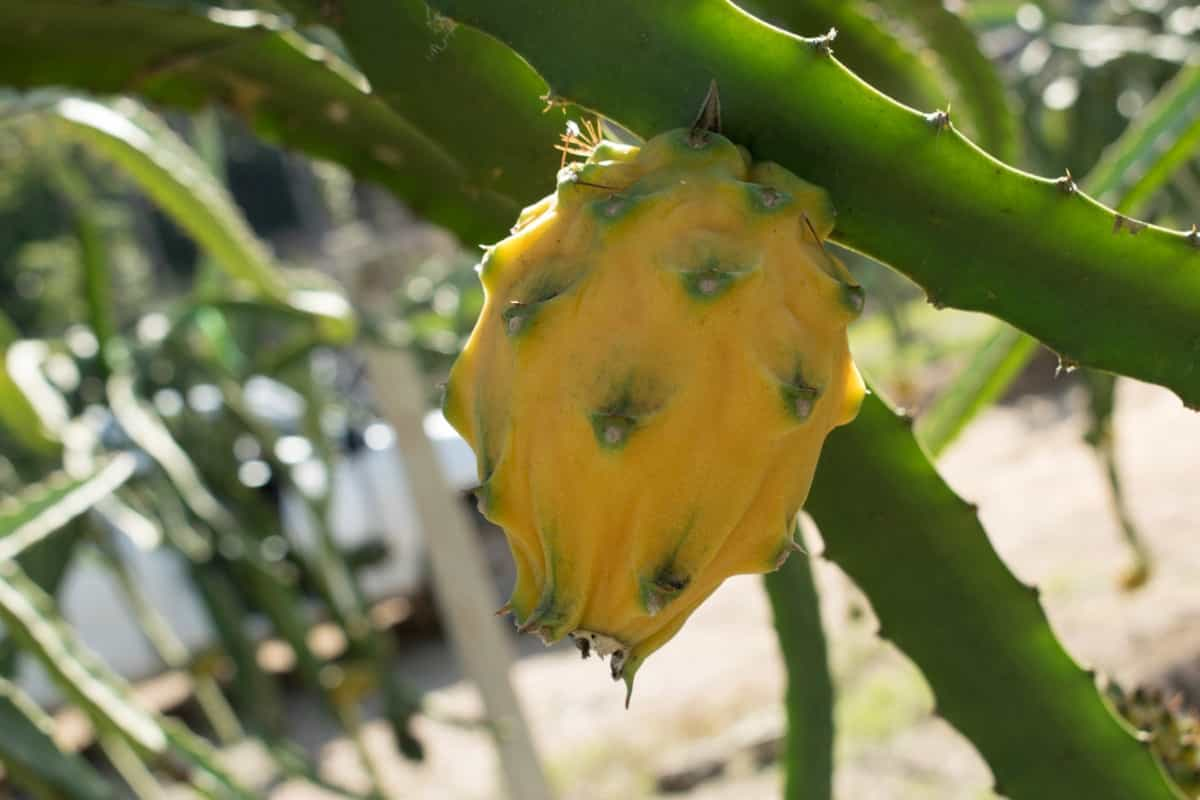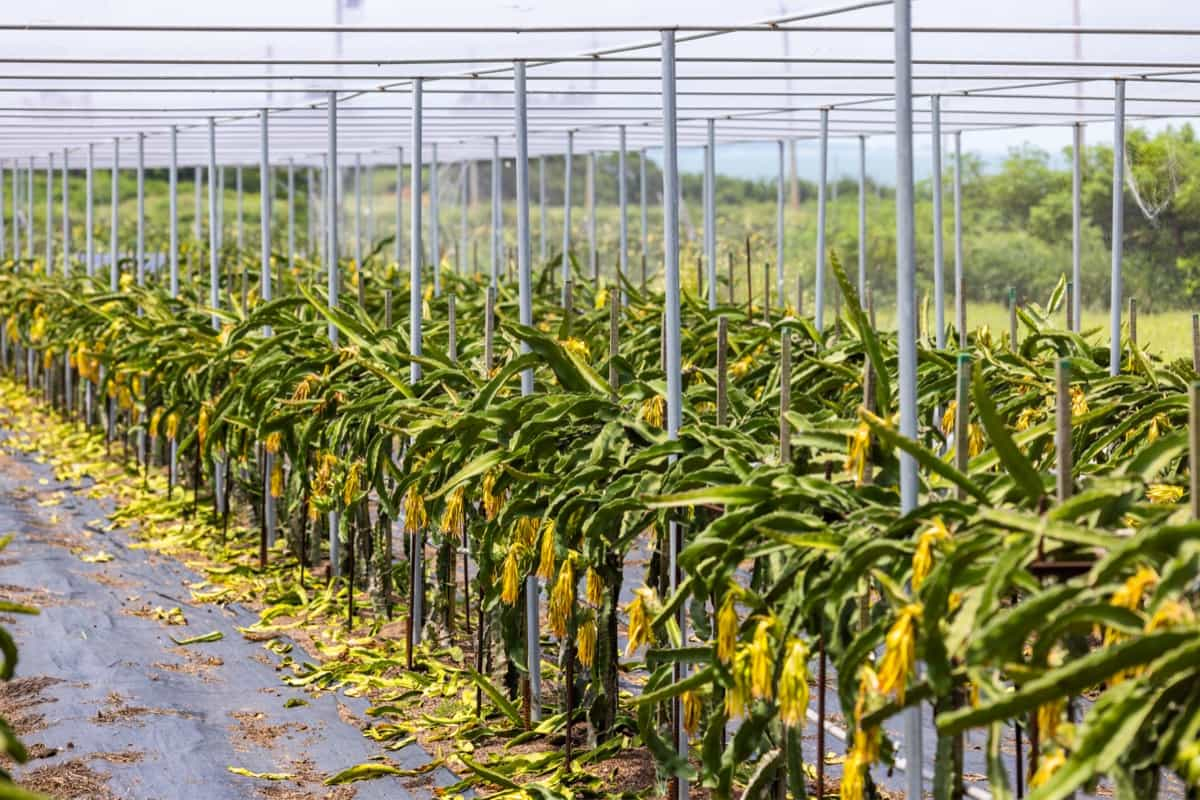Pruning involves the removal of excess stems and branches, promoting better aeration, light penetration, and nutrient distribution, which enhances overall plant health. Proper training supports the growth of a sturdy and manageable framework, aiding in efficient fruit production and ease of harvest. These practices also help maintain a balanced plant structure, reducing disease risk and pest infestations. By optimizing plant growth and health, pruning and training are essential for maximizing dragon fruit yields and ensuring the long-term vitality of the crop.

Pruning and Training Methods for Dragon Fruit Plants
Step-by-Step Guide to Pruning and Training Dragon Fruit Plants for Optimal Growth
- After planting, trim the main stem to encourage branching.
- Set up a sturdy trellis or support system near the plant to facilitate growth.
- Train the main stem to grow vertically along the support structure using soft ties or twine.
- Allow lateral branches to develop, ensuring they are evenly spaced along the main stem.
- Regularly trim excess or crossing branches to maintain a balanced canopy.
- Promptly remove any diseased or damaged growth to prevent spread.
- Encourage flowering and fruiting by promoting lateral branch growth and providing adequate support.
- Continue to prune and train throughout the plant’s life to optimize fruit production and maintain plant health.
Exploring Different Pruning Methods for Dragon Fruit Plants: A Comprehensive Overview
- Initial Pruning: After planting, trim the main stem to encourage branching, promoting a bushier growth habit.
- Lateral Branch Pruning: Regularly remove excess lateral branches to maintain optimal spacing and airflow, preventing overcrowding and disease.
- Tip Pruning: By periodically pinching off the growing tips of branches, you can stimulate the development of more lateral branches, leading to increased fruit production.
- Fruit Removal: In cases of overproduction or to prioritize fruit quality, selectively remove excess fruit, allowing the plant to redirect energy into growth and development.
- Canopy Management: Adjust the height and width of the canopy by pruning branches strategically to control the plant’s size and shape.
In case you missed it: How to Stop Flower Drop and Fruit Drop in Dragon Fruit Plants

The Benefits of Pruning and Training Methods Dragon Fruit Plant in Enhancing Productivity
- Proper pruning stimulates the growth of new branches and flower buds, leading to a higher yield of dragon fruits.
- Improved airflow and reduced crowding help prevent fungal and bacterial diseases, ensuring a healthier plant.
- Pruning allows for better light penetration, ensuring all plant parts receive adequate sunlight for photosynthesis and fruit development.
- A well-trained plant with controlled growth makes harvesting easier and reduces the risk of injury during the process.
- Pruning and training help maintain a balanced plant structure, promoting long-term plant health and vitality.
Best Practices for Pruning and Training Dragon Fruit Plants: Maximizing Yield and Quality
- Begin by pruning the main stem to encourage branching, setting the stage for a bushier plant.
- Routinely examine your dragon fruit plant for diseased or damaged growth and promptly remove any affected sections to prevent further spread.
- Trim excess lateral branches that compete for space and light, ensuring the remaining branches are well-spaced and receive adequate airflow.
- Adjust the canopy’s height and width as needed to control plant size and shape, promoting efficient growth and ease of harvest.
- In periods of overproduction, selectively remove excess fruit to enhance the quality and size of the remaining fruits.
- Invest in a robust trellis or support system to bear the weight of the growing plant and its fruits.
Unveiling the Secrets of Successful Pruning and Training Techniques for Dragon Fruit Plants
- Balanced Growth: Pruning and training create a well-structured plant, optimizing sunlight exposure and nutrient distribution for even fruit development.
- Optimized Airflow: Adequate spacing and minimal crowding from pruning minimize the risk of diseases and enhance overall plant health.
- Enhanced Flowering: Tip pruning and lateral branch management stimulate flowering, boosting the potential for fruit production.
- Ease of Harvest: A well-trained plant is easier to manage and harvest, reducing the risk of damage to fruits or plant structures.
- Long-Term Vitality: Consistent pruning and training practices promote plant longevity, ensuring a sustained and productive dragon fruit crop.
In case you missed it: How to Grow Dragon Fruits Organically: Organic Cultivation Practices

A Comparative Analysis of Various Pruning and Training Methods for Dragon Fruit Plants
Traditional upright trellising promotes vertical growth, yielding more fruit but requiring substantial space. Low trellising enhances fruit accessibility but sacrifices yield. In contrast, the single-arm cordon system offers a balanced compromise, optimizing yield and harvesting ease. Additionally, periodic pruning, especially during the dormant season, increases fruit quality and reduces disease incidence. Overall, the choice of method should consider the grower’s space constraints and preferences, with single-arm cordon and regular pruning showing promise for dragon fruit cultivation.
Mastering the Art of Pruning and Training Dragon Fruit Plants: Tips and Tricks for Success
Start by selecting a suitable trellis system, such as the single-arm cordon, which balances fruit accessibility and yield. Regular pruning, especially during the dormant season, helps maintain the desired shape and reduce disease risks. Maintain a consistent watering and fertilization schedule to support vigorous growth. Additionally, monitor for pests and diseases, addressing them promptly. By implementing these tips and tricks, dragon fruit growers can ensure success, fostering healthy plants and bountiful harvests while minimizing challenges and setbacks.
Advanced Pruning and Training Strategies for Commercial Dragon Fruit Plantations
Employ a V-shaped trellis system for high-density planting, facilitating light penetration and increased yield per unit area. Implement multi-arm cordon pruning to balance fruit production and facilitate mechanical harvesting. Rigorous pruning during dormancy should be supplemented with precision summer pruning to manage excessive vegetative growth.
Utilize specialized machinery for large-scale operations. Consistent irrigation and nutrition management are vital to support plant health and fruit quality. Regular monitoring for pests and diseases and early intervention ensure a successful, high-yield dragon fruit operation that meets commercial demands and quality standards.
Troubleshooting Common Issues in Pruning and Training Dragon Fruit Plants
Over-pruning can stunt growth and reduce fruit production; avoid it by adhering to recommended pruning schedules. Under-pruning results in overcrowded growth, hampering fruit development. Inadequate trellis support may lead to plant stress or fruit damage, necessitating proper structural adjustments. Addressing these issues promptly through proper care, pruning, and training techniques is essential for maintaining robust, high-yielding dragon fruit plants.
Frequently Asked Questions on Pruning and Training Methods for Dragon Fruit Plants
How Do You Prune a Dragon Fruit Plant?
Prune a dragon fruit plant by cutting back overgrown or damaged stems and removing any dead or diseased growth. Keep it simple to encourage new growth and maintain its shape.
In case you missed it: Harvesting and Post-Harvest Handling of Dragon Fruits: Marketing Strategies

What Is the Training System Of Dragon Fruit?
Dragon fruit is typically trained using a trellis system, where young plants are tied to support structures to encourage upward growth. They’re trained to fan out along the trellis as they grow, optimizing sunlight exposure and facilitating easier harvesting.
Should You Prune Dragonfruit?
It would help if you pruned dragonfruit to encourage growth and maintain the plant’s shape. Pruning helps remove damaged or dead growth, stimulates new growth, and promotes a healthier and more productive dragonfruit cactus.
Conclusion
By covering these topics, you’ll have a comprehensive guide to help both beginners and experienced growers effectively prune and train dragon fruit plants, ensuring a successful and productive cultivation process.
- Feed Your Flock for Less: Top 10 Tips to Save on Chicken Feed
- Ultimate Guide to Ossabaw Island Hog: Breeding, Raising, Diet, and Care
- Hatching Answers: The Top 10 Reasons Your Chickens Aren’t Laying Eggs
- Eggs and Economics: Breaking Down the Cost of Raising Backyard Chickens
- Defend Your Greens: Proven Methods to Keep Iguanas Out of Your Garden
- Ultimate Guide to Cinnamon Queen Chicken: A Comprehensive Guide for Beginners
- Ultimate Guide to California Tan Chicken: Breeding, Raising, Diet, Egg-Production and Care
- Ultimate Guide to Marsh Daisy Chicken: Breeding, Raising, Diet, and Care
- 10 Types of Chicken Farming Businesses You Can Start for Profits